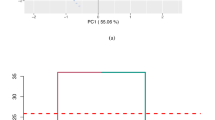Synopsis
Data matrices of fish stomach contents frequently contain many zeros, and nonzero values often do not follow usually encountered statistical distributions. Therefore, many common methods of statistical analysis are inappropriate for such data. A method of repeated k-means cluster analysis is proposed for exploratory analysis of data sets on fish stomach contents. Objective rules are proposed for setting the clustering parameters, so the arbitrariness and subjectivity common in interpreting hierarchical clustering methods is avoided. Because the clusters are nonhierarchical, the analysis method also requires much less computer time and memory. Application of the method is illustrated with a data set of 1771 stomachs of cod (Gadus morhua), feeding on 38 different prey types. The results of the clusterings reveal that nine types of prey may account for the systematic information about the diet of cod in this sample from the northern Grand Bank in Spring of 1979. The results are also used to test specific hypotheses about size selectivity of the predator, spatial variation of feeding, environmental influences on diet, and relative preferences among prey taxa.
Similar content being viewed by others
References cited
Berg, J. 1979. Discussion of methods of investigating the food of fishes, with reference to a preliminary study of the prey of Gobiusculus flaveseens (Gobiidae). Mar. Biol. 50: 263–273.
Bowen, S.H. 1983. Quantitative description of the diet, pp. 325–336. In: L.A. Nielsen & D.L. Johnson (ed.) Fisheries Techniques, Amer. Fish. Society. Bethesda.
Caswell, H. 1976. Community structure: A neutral model analysis. Ecol. Monogr. 46: 327–354.
Colgan, P.W. & J.J. Smith. 1985. Experimental analysis of food preference transitivity in fish. Biometrics 41: 227–236.
Crow, M.E. 1982. Some statistical techniques for analyzing the stomach contents of fish. p. 8–15. In: G.M. Cailliet & C.A. Simenstad (ed.) Gutshop '81: Fish Food Habits Studies; Proceedings of the Third Pacific Workshop. Washington Sea Grant Publication, Seattle.
Daan, N. 1973. A quantitative analysis of the food intake of North Sea cod, Gadus morhua. Neth.J. Sea Res. 6: 479–517.
Everitt, B. 1974. Cluster analysis. Heinemann Educational Books, Ltd., London. 122 pp.
Gauch, H.G. Jr. 1979. COMPCLUS — a FORTRAN program for rapid initial clustering of large data sets. Cornell Univ. Ithaca. 59 pp.
Gauch, H.G. Jr. 1982. Multivariate analysis in community ecology. Cambridge Univ. Press, Cambridge. 312 pp.
Hyslop, E.J. 1980. Stomach contents analysis — a review of methods and their application. J. Fish Biol. 17: 411–429.
Kessler, W.B., W.F. Kasworm & W.L. Brodie. 1981. Three methods compared for analysis of pronghorn diet. J. Wildl. Manag. 45: 612–619.
Kohler, C.C. & J.J. Ney. 1982. A comparison of methods for quantitative analysis of feeding selection of fishes. Env. Biol. Fish. 7: 363–368.
Levy, D.A. & I. Yesaki. 1982. Graphical methods for fish stomach analysis. pp. 16–23. In: G.M. Cailliet & C.A. Simenstad (ed.) Gutshop '81: Fish Food Habit Studies; Proceedings of the Third Pacific Workshop. Washington Sea Grand Publ., Seattle.
Lilly, G.R. & A.M. Fleming. 1981. Size relationships in predation by Atlantic cod, Gadus morhua, on capelin, Mallotus villosus, and sand lance, Ammodytes dubius, in the Newfoundland area. NAFO Sci. Coun. Studies 1: 41–45.
MacDonald, J.S. & R.H. Green. 1983. Redundancy of variables used to describe importance of prey species in fish diets. Can. J. Fish. Aquat. Sci. 40: 635–637.
Martin, I.D. & R.J. Mackay. 1982. Interpreting the diet of Rhyacophila larvae (Trichoptera) from gut analyses: an evaluation of techniques. Can. J. Zool. 60: 783–789.
Pielou, E.C. 1984. The interpretation of ecological data: A primer on classification and ordination. John Wiley & Sons, New York. 263 pp.
Ramsey, F.L. & C.P. Marsh. 1984. Diet dissimilarity. Biometrics 40: 707–715.
Ratkowski, D.A. & G.N. Lance. 1978. A criterion for determining the number of groups in a classification. Austral. Comp. J. 10: 115–117.
Robb, A.B. & J.R.G. Hislop. 1980. The food of five gadoid species during the pelagic 0-group phase in the North Sea. J. Fish Biol. 16: 199–217.
Romesburg, H.C. 1984. Cluster analysis for researchers. Lifetime Learning Publ. Belmont. 334 pp.
SAS Institute, Inc. 1985. SAS User's guide: Statistics, Version 5 Edition. SAS Institute Inc., Cary. 959 pp.
Smith, E.P. 1985. Estimating the reliability of diet overlap measures. Env. Biol. Fish. 13: 125–138.
Sneath, P.H. & R.R. Sokal. 1973. Numerical taxonomy. W.H. Freeman & Co. San Francisco. 574 pp.
Sokal, R.R. & F.J. Rohlf. 1981. Biometry. W.H. Freeman & Co., San Francisco. 859 pp.
Strauss, R.E. 1982. Influence of replicated subsamples and subsample heterogeneity on the linear index of food selection. Trans. Amer. Fish. Soc. 111: 517–522.
Ursin, E. 1973. On the prey size preferences of cod and dab. Meddr. Daum. Fisk. og Havunders., N.S. 7: 85–98.
Wankowski, J.W.J. 1979. Morphological limitations, prey size selectivity, and growth response of juvenile Atlantic salmon Salmo salar. J. Fish Biol. 14: 89–100.
Wishart, D. 1978. CLUSTAN user's manual. Inter-University/Research Councils Series Report No. 47 (3rd Edition). Edinburgh University, Edinburgh. 175 pp.
Windell, J.T. & S.H. Bowen. 1978. Methods for study of fish diets based on analysis of stomach contents. pp. 219–226. In: T. Bagnel (ed.) Methods for the Assessment of Fish Production in Fresh Waters, 3rd Edition. Blackwell Scientific Publ. Oxford.
Author information
Authors and Affiliations
Rights and permissions
About this article
Cite this article
Rice, J.C. Repeated cluster analysis of stomach contents data: method and application to diet of cod in NAFO division 3L. Environ Biol Fish 21, 263–277 (1988). https://doi.org/10.1007/BF00000375
Received:
Accepted:
Issue Date:
DOI: https://doi.org/10.1007/BF00000375




